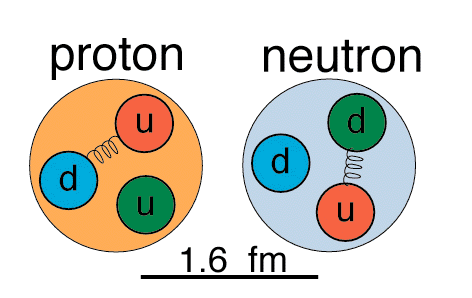
|Intro| - |Sizes| - |Tour| - |Help|
[Quarks] - <Nucleons> - [Nucleus] - [Atom] - [Cell] - [People]
The proton carries a charge of +1 (in units of the electron charge) and the neutron is neutral (zero charge).
Protons and neutrons are themselves made up of quarks as this schematic picture indicates. In the quark model, the only difference between a proton and a neutron is that an up quark has been replaced with a down quark.

A nucleon is about 1.6 fm in diameter (fm stands for femto meter, where femto is the prefix meaning 10-15, sometimes written as 10^{-15} when superscripts are not available in text), which you might write as 0.0000000000000016 m. That is pretty small, but not much smaller than a nucleus. That is because the force that holds the nucleus together is very short range, so the protons and neutrons in a nucleus are packed together so they are almost touching each other.